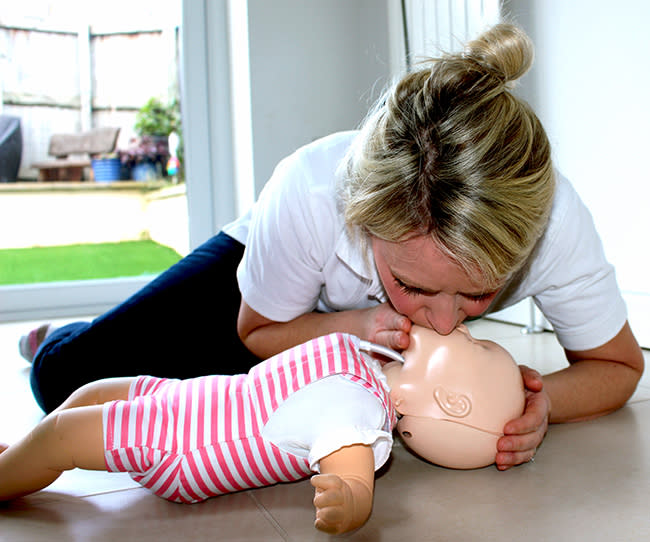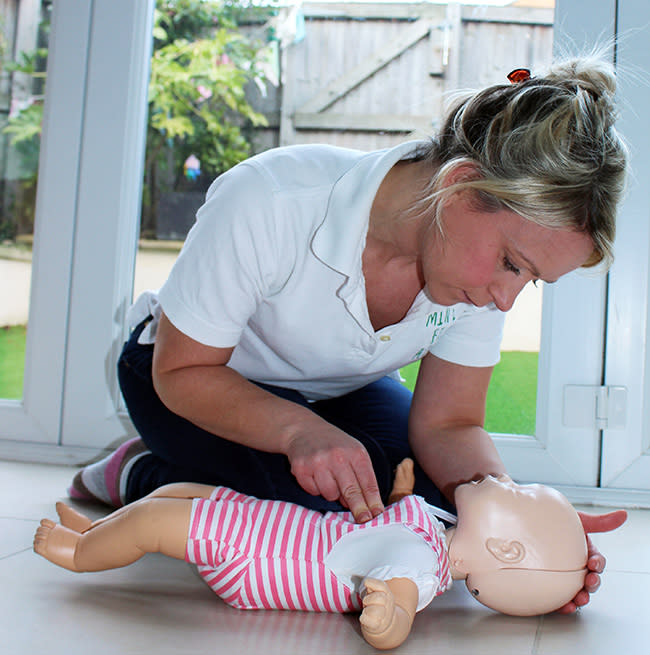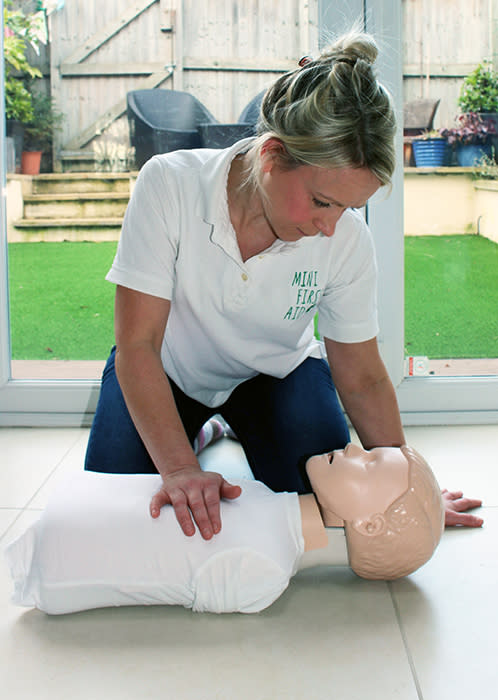5 life-saving first aid tips for parents to know
It's every parent's worst nightmare for their child to fall seriously ill or have a bad accident, so it's essential to be prepared with some basic first aid skills should the worst happen.
MORE: The best and safest newborn car seats for your baby 2022
HELLO! asked Kate Ball of Mini First Aid to share life-saving first aid tips for parents. Mini First Aid is the UK’s largest specialist Paediatric First Aid training company, having appeared on Dragons' Den and securing investment from Sara Davies MBE.
Below, Mini First Aid share their top first aid advice and guidance for CPR, febrile seizures, head bumps, burns and choking.
How to perform CPR on a baby or child
There are many reasons for a little one to stop breathing. Adults tend to have a cardiac event meaning the heart is not functioning. Children tend to have respiratory compromise therefore breathing is affected.
RESPONSE
A quick assessment of unconsciousness established by a tap on the foot or shoulder and calling their name to see if they respond.
AIRWAY
Open by tilting head and lifting the chin.
BREATHING
Look listen and feel for a maximum of 10 seconds for normal breathing If your baby or child is not breathing and unresponsive you need to SHOUT FOR HELP and start CPR.
CPR for a baby under 1
1) With the airway open, give 5 Initial rescue breaths by placing your mouth over your baby’s mouth and nose, forming a seal and blowing into their mouth.

2) Do 30 chest compressions – pressing down firmly with 2 fingers in the centre of the chest at a rate of 100-120 per minute.

3) Then give 2 rescue breaths followed by 30 chest compressions and repeat. If your baby starts to breathe, place her in the recovery position on her side, with their head tilted back until emergency help arrives.
MORE: Baby sleep: 6 top tips for better and safer sleeping
CPR for a child over 1
1) With the airway open. Give 5 initial rescue breaths by placing your mouth over your child’s nose, forming a seal and blowing into their mouth.

2) Do 30 chest compressions – pressing down firmly with the heel of one hand in the centre of the chest at a rate of 100-120 per minute.

3) Then give 2 rescue breaths followed by 30 chest compressions and repeat.
4) If your child starts to breathe, place him/her in the recovery position on her side, with their head tilted back until emergency help arrives.
MORE: Best Baby Moses baskets for newborns 2022: 10 cute and comfortable beds for your baby
Dealing with choking
It’s vital that all parents and carers know how to deal with a baby who is choking.
Choking Baby (aged 0-1):
Give 5 back slaps.
Up to 5 chest thrusts (jabbing motion). Check if anything comes out. If nothing has come out, call 999.
Cycles of 5 back slaps and 5 chest thrusts
WATCH: How to deal with a baby who is choking
You must always refer to hospital any child or baby who has been choking and where abdominal manoeuvres have been used.
Choking child (aged 1+):
Encourage the child to cough.
5 back slaps between shoulder blades. Check if anything comes out and check the mouth.
Up to 5 abdominal thrusts. Clenched fist between tummy and breastbone, with the other hand over the top. In an upwards motion. Check if anything comes out. If nothing has come out, call 999.
Cycles of 5 back slaps & 5 abdominal thrusts.
WATCH: How to deal with a child who is choking
Tips for safe weaning
To keep babies safe, foods need to be ‘squishable’ between the thumb and forefinger (so no raw apple or carrot) and need to be roughly ‘baby fist’ size or ‘chip' sized. This is to enable babies to hold food securely and gnaw off what they can manage.
Avoiding round or cubed pieces of food such as cubes of cheese and whole grapes is important too. A lot of people don’t realise that with babies, bigger pieces of food are so much safer and easier to manage than little chunks.
Did you know popcorn, as well as all of the below, are considered to be some of the riskiest choking hazards for babies & young children?
Whole Grapes
Popcorn
Cherry Tomatoes
Lollies & Boiled Sweets
Hotdogs & Sausages
Marshmallows
Make sure to chop all food appropriately for your baby/young child and avoid foods such as popcorn, marshmallow & hard sweets. Make sure your babysitters know too!
MORE: How to wean your baby: when to start, foods to offer and common problems
What to do if your child has a febrile seizure
Febrile seizures are commonly caused in young children by a raised body temperature or fever. Signs and symptoms include:
Violent muscle twitching
Hot, flushed skin
Twitching of the face
Breath-holding
Loss of consciousness

Treatment for seizures:
Protect the child with pillows and padding
Remove clothing
Ensure a supply of fresh air
Check for breathing
Place baby in the recovery position - on their side with head tilted back
Call 999
MORE: Ultimate tips and tricks for travelling with a baby
Taking your baby or child's temperature
If you think your baby has a high temperature, usually considered to be a temperature of 38°C or above, it's best to check their temperature with a thermometer. This can help you work out whether you need to get medical advice.
To take your child's temperature:
Hold them comfortably on your knee and put the thermometer in their armpit – always use the thermometer in the armpit with children under 5 years.
Gently, but firmly, hold their arm against their body to keep the thermometer in place for however long it says in the manufacturer's instructions – usually about 15 seconds. Some digital thermometers beep when they're ready.
The display on the thermometer will then show your child's temperature.
You can buy other types of thermometers, but they may not be as accurate as a digital thermometer for taking a baby or young child's temperature, such as:
Ear (tympanic) thermometers – these allow you to take a temperature reading from the ear and are quick but expensive; they can give misleading readings if you do not put them in the ear correctly, which is more likely to happen with babies because their ear holes are so small
Strip-type thermometers – these are held against the forehead and are not an accurate way of taking a temperature. They show the temperature of the skin, rather than the body Source: NHS
MORE: 6 of the best reusable nappies – tried and tested by parents
Burns Advice
If your child suffers a burn:
Run the affected area under cool (not cold) water for 20 minutes (a surprising number of parents do not know this).
Cover the burn with CLINGFILM, or a sterile, non-fluffy dressing or cloth.
Keep your child warm (not the burnt area) and take them to A&E.

How to treat head bumps
Everyone dreads a bump on the head, especially as your baby becomes mobile. Why is it they seem to spend their time bumping into things?! Most bumps are nothing to worry about, but it is better to be cautious, particularly with bumps to the head.
Here are our top tips:
Where possible, babyproof your home to minimise the risk of bumps.
If your baby bumps his/her head, use a cold compress (either from the fridge or a wet paper towel) and apply to the bump for 10 minutes.
During the 10 minutes encourage your baby to rest and relax. For a toddler/young child perhaps read a story so you can monitor them.
Any signs of sickness, drowsiness, dizziness or any unnatural behaviour could be concussion. You need to take get your baby to A&E as soon as possible.
If you are leaving your baby with a carer after a head bump, make sure you tell them so that they can continue to monitor your baby for any signs of concussion.
Adults looking after your children
Make sure that all adults in contact with your child have been first aid trained. Our class covers choking, basic life support, dealing with burns, breaks and bumps, febrile seizures and meningitis awareness.
The importance of a first aid kit
Always keep a well-stocked first aid kit to hand, both at home and when you're out and about. Our Family First Aid Kit fits neatly into any changing bag.
Come and learn these vital techniques at a Mini First Aid class near you. Visit Mini First Aid's website and @minifirstaid on Instagram
Like this story? Sign up to the HELLO! Family Hub newsletter to get other stories like this delivered straight to your inbox.



